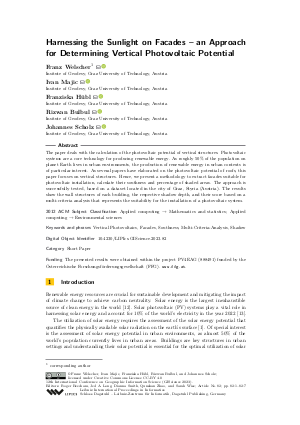Harnessing the Sunlight on Facades - an Approach for Determining Vertical Photovoltaic Potential (Short Paper)
Authors
Franz Welscher  ,
Ivan Majic
,
Ivan Majic  ,
Franziska Hübl
,
Franziska Hübl  ,
Rizwan Bulbul
,
Rizwan Bulbul  ,
Johannes Scholz
,
Johannes Scholz 
-
Part of:
Volume:
12th International Conference on Geographic Information Science (GIScience 2023)
Part of: Series: Leibniz International Proceedings in Informatics (LIPIcs)
Part of: Conference: International Conference on Geographic Information Science (GIScience) - License:
 Creative Commons Attribution 4.0 International license
Creative Commons Attribution 4.0 International license
- Publication Date: 2023-09-07
File

PDF
LIPIcs.GIScience.2023.82.pdf
- Filesize: 1 MB
- 7 pages
Document Identifiers
Subject Classification
ACM Subject Classification
- Applied computing → Mathematics and statistics
- Applied computing → Environmental sciences
Keywords
- Vertical Photovoltaics
- Facades
- Southness
- Multi-Criteria-Analysis
- Shadow
Metrics
- Access Statistics
-
Total Accesses (updated on a weekly basis)
0PDF Downloads0Metadata Views
Abstract
The paper deals with the calculation of the photovoltaic potential of vertical structures. Photovoltaic systems are a core technology for producing renewable energy. As roughly 50% of the population on planet Earth lives in urban environments, the production of renewable energy in urban contexts is of particular interest. As several papers have elaborated on the photovoltaic potential of roofs, this paper focuses on vertical structures. Hence, we present a methodology to extract facades suitable for photovoltaic installation, calculate their southness and percentage of shaded areas. The approach is successfully tested, based on a dataset located in the city of Graz, Styria (Austria). The results show the wall structures of each building, the respective shadow depth, and their score based on a multi-criteria analysis that represents the suitability for the installation of a photovoltaic system.
Cite As Get BibTex
Franz Welscher, Ivan Majic, Franziska Hübl, Rizwan Bulbul, and Johannes Scholz. Harnessing the Sunlight on Facades - an Approach for Determining Vertical Photovoltaic Potential (Short Paper). In 12th International Conference on Geographic Information Science (GIScience 2023). Leibniz International Proceedings in Informatics (LIPIcs), Volume 277, pp. 82:1-82:7, Schloss Dagstuhl – Leibniz-Zentrum für Informatik (2023)
https://doi.org/10.4230/LIPIcs.GIScience.2023.82
BibTex
@InProceedings{welscher_et_al:LIPIcs.GIScience.2023.82,
author = {Welscher, Franz and Majic, Ivan and H\"{u}bl, Franziska and Bulbul, Rizwan and Scholz, Johannes},
title = {{Harnessing the Sunlight on Facades - an Approach for Determining Vertical Photovoltaic Potential}},
booktitle = {12th International Conference on Geographic Information Science (GIScience 2023)},
pages = {82:1--82:7},
series = {Leibniz International Proceedings in Informatics (LIPIcs)},
ISBN = {978-3-95977-288-4},
ISSN = {1868-8969},
year = {2023},
volume = {277},
editor = {Beecham, Roger and Long, Jed A. and Smith, Dianna and Zhao, Qunshan and Wise, Sarah},
publisher = {Schloss Dagstuhl -- Leibniz-Zentrum f{\"u}r Informatik},
address = {Dagstuhl, Germany},
URL = {https://drops.dagstuhl.de/entities/document/10.4230/LIPIcs.GIScience.2023.82},
URN = {urn:nbn:de:0030-drops-189777},
doi = {10.4230/LIPIcs.GIScience.2023.82},
annote = {Keywords: Vertical Photovoltaics, Facades, Southness, Multi-Criteria-Analysis, Shadow}
}
Author Details
Funding
The presented results were obtained within the project PV4EAG (888491) funded by the Österreichische Forschungsförderungsgesellschaft (FFG). https://www.ffg.at.
References
-
Athanasios Angelis-Dimakis, Markus Biberacher, Javier Dominguez, Giulia Fiorese, Sabine Gadocha, Edgard Gnansounou, Giorgio Guariso, Avraam Kartalidis, Luis Panichelli, Irene Pinedo, et al. Methods and tools to evaluate the availability of renewable energy sources. Renewable and sustainable energy reviews, 15(2):1182-1200, 2011.

-
Miguel Centeno Brito, Paula Redweik, Cristina Catita, Sara Freitas, and Miguel Santos. 3d solar potential in the urban environment: A case study in lisbon. Energies, 12(18):3457, 2019.

- Zoran Cuckovic. Terrain shading: a qgis plugin for modelling natural illumination over digital terrain models, 2021. URL: https://github.com/zoran-cuckovic/QGIS-terrain-shading.
- Gilles Desthieux, Claudio Carneiro, Reto Camponovo, Pierre Ineichen, Eugenio Morello, Anthony Boulmier, Nabil Abdennadher, Sébastien Dervey, and Christoph Ellert. Solar energy potential assessment on rooftops and facades in large built environments based on lidar data, image processing, and cloud computing. methodological background, application, and validation in geneva (solar cadaster). Frontiers in Built Environment, 4, 2018. URL: https://doi.org/10.3389/fbuil.2018.00014.
-
D Douglas and T Peuker. Algorithms for the reduction of the number of points required to represent a digitized line or its caricature. The International Journal for Geographic Information and Geovisualization, 10:112-122, 1973.

- Elham Fakhraian, Marc Alier, Francesc Valls Dalmau, Alireza Nameni, and José Casañ Guerrero. The urban rooftop photovoltaic potential determination. Sustainability 2021, Vol. 13, Page 7447, 13:7447, July 2021. URL: https://doi.org/10.3390/SU13137447.
-
Hubert Fechner. Ermittlung des Flächenpotentials für den Photovoltaik-Ausbau in Österreich. Studie im Auftrag von Österreichs Energie, pages 1-69, 2020.

- Christian Mikovits, Thomas Schauppenlehner, Patrick Scherhaufer, Johannes Schmidt, Lilia Schmalzl, Veronika Dworzak, Nina Hampl, and Robert Gennaro Sposato. A spatially highly resolved ground mounted and rooftop potential analysis for photovoltaics in austria. ISPRS International Journal of Geo-Information, 10, 2021. URL: https://doi.org/10.3390/IJGI10060418.
- Arnadi Murtiyoso, Mirza Veriandi, Deni Suwardhi, Budhy Soeksmantono, and Agung B Harto. Automatic Workflow for Roof Extraction and Generation of 3D CityGML Models from Low-Cost UAV Image-Derived Point Clouds, 2020. URL: https://doi.org/10.3390/ijgi9120743.
- Jesús Polo, Nuria Martín-Chivelet, Miguel Alonso-Abella, and Carmen Alonso-García. Photovoltaic generation on vertical façades in urban context from open satellite-derived solar resource data. Solar Energy, 224(June):1396-1405, 2021. URL: https://doi.org/10.1016/j.solener.2021.07.011.
- P. Redweik, C. Catita, and M. Brito. Solar energy potential on roofs and facades in an urban landscape. Solar Energy, 97:332-341, 2013. URL: https://doi.org/10.1016/j.solener.2013.08.036.
-
Naveed Rehman. Solar Energy Potential Assessment On Façades Using Geo-referenced Digital Elevation Models. PhD thesis, Auckland University of Technology, 2021.

-
REN21. Renewables 2022 global status report. Technical report, REN21 Secretariat, 2022.

- Laura Romero Rodríguez, Eric Duminil, José Sánchez Ramos, and Ursula Eicker. Assessment of the photovoltaic potential at urban level based on 3D city models: A case study and new methodological approach. Solar Energy, 146:264-275, 2017. URL: https://doi.org/10.1016/j.solener.2017.02.043.
